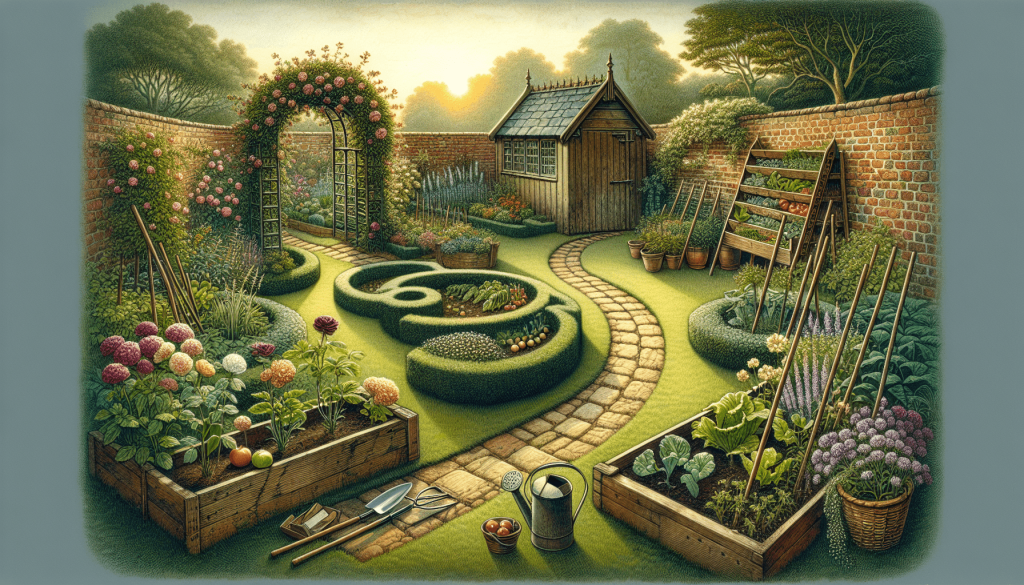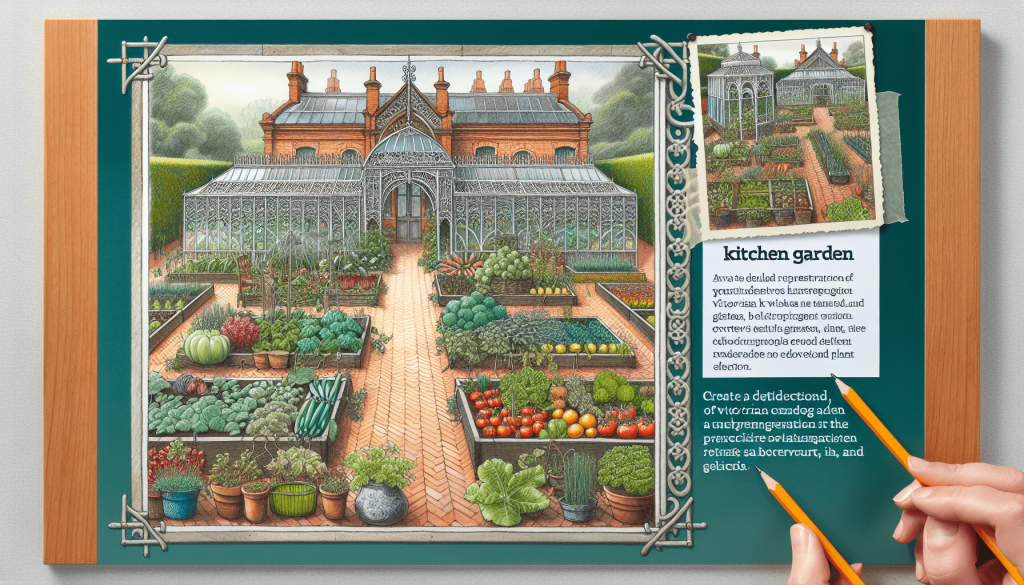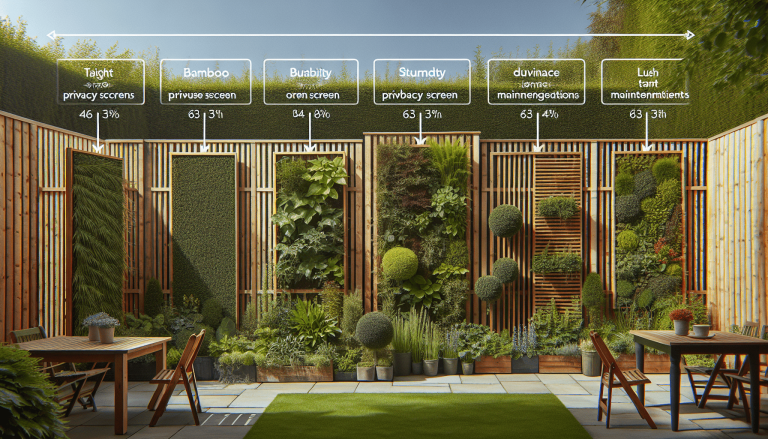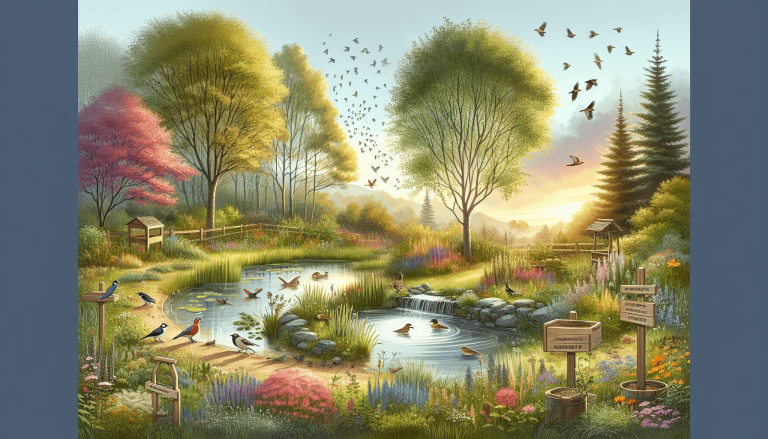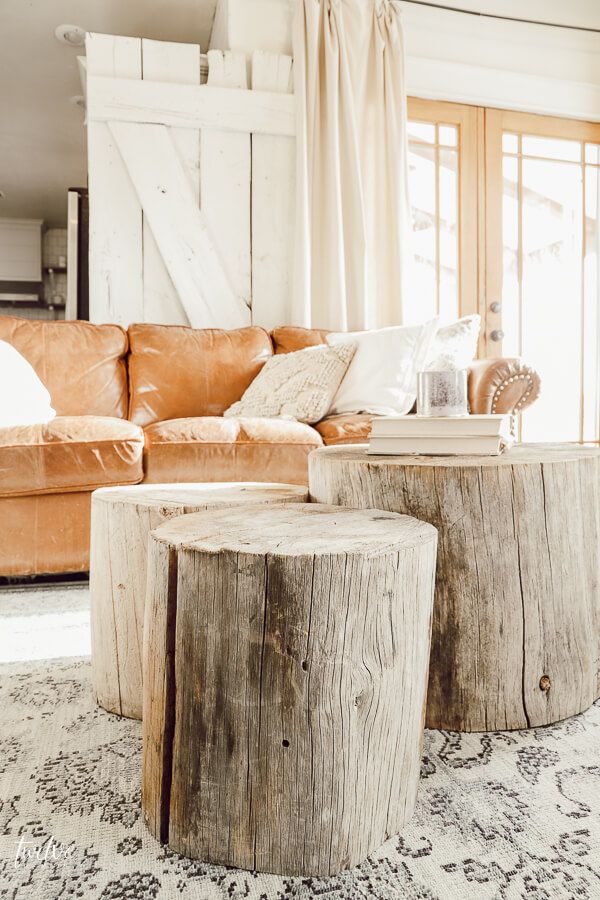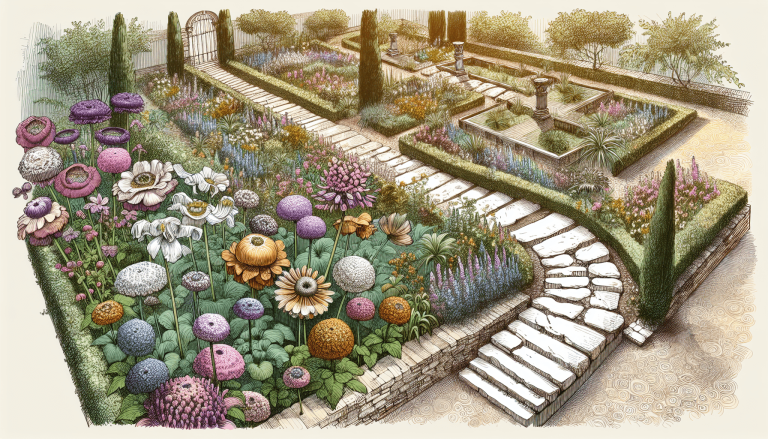Imagine stepping into a charming garden that seems to have been transported straight out of a Victorian-era novel. Picture yourself surrounded by colorful blooms, lush greenery, and a quaint ambiance that evokes a sense of nostalgia. Creating a garden with a Victorian kitchen garden theme is not only a delightfully nostalgic endeavor but also an opportunity to infuse your outdoor space with elegance and history. By carefully selecting heirloom plants, incorporating intricate hardscape elements, and paying attention to small details, you can transform your garden into a picturesque retreat that harkens back to a bygone era.
Table of Contents
ToggleChoosing the Right Location
Consider the climate and sunlight
When creating a Victorian kitchen garden, one of the first things to consider is the climate and sunlight of your chosen location. Victorian gardens often thrived in moderate climates with a good amount of sunshine. This means you should choose a spot in your garden that receives ample sunlight throughout the day. Additionally, it is important to take into account the climate of your area. Some plants thrive in cooler temperatures, while others prefer warmer climates. By understanding the climate and sunlight requirements of different plants, you can ensure that your Victorian garden will flourish in its designated location.
Find a spot with good drainage
Another important aspect to consider when selecting a location for your Victorian kitchen garden is the drainage. Victorian plants, like many other plants, require proper drainage to prevent waterlogging and promote healthy growth. Look for a spot in your garden that has well-draining soil or consider adding raised beds to improve drainage. Avoid areas that are prone to standing water or have heavy clay soil, as these conditions can lead to root rot and other plant diseases.
Ensure easy access to water
Watering is an essential part of maintaining any garden, including a Victorian kitchen garden. Ensure that your chosen location has easy access to a water source, such as a nearby hose or irrigation system. Victorian plants, particularly during the summer months, may require consistent watering to thrive and produce bountiful harvests. Having convenient access to water will make the task of watering your plants much more manageable and enjoyable.
Researching Victorian Garden Designs
Study historical sources and references
To truly capture the essence of a Victorian kitchen garden, it is important to take the time to study historical sources and references. Look for books, articles, and photographs that depict Victorian era gardens. By immersing yourself in the history of Victorian gardens, you can gain a deeper understanding of the various design elements and plant choices that were popular during that time. This knowledge will serve as a valuable guide as you begin designing and planning your own Victorian garden.
Look for inspiration in Victorian era literature and photographs
In addition to studying historical sources, Victorian era literature and photographs can provide inspiration for your garden design. Explore novels, poetry, and even cookbooks from the Victorian era that mention or depict gardens. Look for detailed descriptions of plants, structures, and layouts that you can incorporate into your own garden. By drawing inspiration from the literary and visual depictions of Victorian gardens, you can create a garden that truly captures the spirit of that era.
Explore the use of geometric patterns and symmetry
One characteristic feature of Victorian gardens is the use of geometric patterns and symmetry in the design. Explore different geometric layouts, such as rectangular or circular beds, and consider incorporating pathways that create a sense of order and balance in your garden. By paying attention to the principles of symmetry and structure, you can create a visually pleasing and authentically Victorian garden design.
Selecting Authentic Victorian Plants
Choose heirloom vegetable varieties
In a Victorian kitchen garden, it is important to choose authentic heirloom vegetable varieties that were commonly grown during that era. Look for heritage seeds or plants that have been historically documented as being popular or traditional in Victorian gardens. Examples of heirloom vegetables include varieties like ‘Scarlet Runner’ beans, ‘Purple Top’ turnips, and ‘Ailsa Craig’ onions. By selecting these authentic plants, you can recreate an important aspect of Victorian gardening and enjoy the unique flavors and qualities of these heritage varieties.
Include traditional kitchen garden staples like herbs and salad greens
No Victorian kitchen garden would be complete without a variety of herbs and salad greens. Consider including traditional staples like parsley, thyme, sage, and mint. These aromatic herbs were commonly used in Victorian cooking and can add a delightful and authentic touch to your garden. Additionally, include salad greens such as lettuce, arugula, and spinach to create a bountiful supply of fresh and healthy greens for your meals.
Consider adding flowers popular in Victorian gardens such as roses and lavender
In addition to vegetables and herbs, Victorian gardens were known for their beautiful floral displays. Consider incorporating flowers that were popular during the Victorian era, such as roses and lavender. Roses, with their romantic and classic appeal, were a favorite among Victorian gardeners. Lavender, with its fragrant blooms and culinary uses, also held a prominent place in these gardens. By including these and other Victorian flowers in your garden, you can create a colorful and vibrant display that captures the essence of the era.
Designing the Garden Layout
Create defined beds and pathways
When designing the layout of your Victorian kitchen garden, it is important to create defined beds and pathways. Victorian gardens often embraced structure and organization, with clearly delineated areas for different plants and activities. Plan out the layout of your garden, using geometric shapes and symmetry, and create distinct beds for vegetables, herbs, and flowers. Introduce pathways that connect the different areas, providing easy access for maintenance and enjoyment.
Incorporate trellises and arches for climbing plants
To add interest and height to your Victorian garden, incorporate trellises and arches for climbing plants. Victorian gardeners often utilized vertical space, allowing vining plants like cucumber, beans, and roses to climb and flourish. Install trellises against walls or fences and add arches over pathways to create a captivating and enchanting atmosphere. Not only will these structures support your climbing plants, but they will also add architectural appeal to your garden.
Designate spaces for seating and relaxation
A Victorian kitchen garden was not only a place for gardening but also a spot for relaxation and leisure. Designate spaces within your garden for seating and relaxation. Consider adding a bench or a small table and chairs, where you can sit and enjoy the beauty of your garden. This will create a cozy and inviting environment that encourages you to spend time outdoors, whether it’s sipping tea or having a quiet moment amidst the greenery.
Using Period-appropriate Garden Structures and Features
Install a Victorian-style greenhouse or cold frame
To truly embrace the Victorian theme in your garden, consider installing a Victorian-style greenhouse or cold frame. Greenhouses were a popular feature in Victorian gardens, providing a controlled environment for growing delicate plants and extending the growing season. Cold frames, on the other hand, were used to protect plants from frost and cold temperatures. By incorporating these structures, you can both add a visually appealing feature to your garden and expand your gardening possibilities.
Include an ornate garden gate or fence
To give your Victorian garden a touch of elegance and charm, include an ornate garden gate or fence. Victorian gardeners often used decorative ironwork or wooden fences adorned with intricate designs. These structures not only define the boundaries of your garden but also add a sense of grandeur and refinement. Choose a gate or fence design that complements the overall style of your garden and enhances its Victorian aesthetic.
Add a decorative bird bath or fountain
Water features were commonly found in Victorian gardens, serving as both decorative elements and sources of water for birds and other wildlife. Add a decorative bird bath or fountain to your garden to create a focal point and attract avian visitors. Choose a design that aligns with the Victorian theme, such as a classical pedestal bird bath or a tiered fountain. The gentle sound of water and the sight of birds splashing will bring life and serenity to your Victorian garden.
Implementing Victorian Garden Techniques
Practice crop rotation for soil health
Crop rotation is an important technique to ensure the long-term health of your Victorian kitchen garden soil. By rotating the types of plants you grow in each bed from year to year, you can help prevent the buildup of pests and diseases and maintain soil fertility. Divide your garden into different sections and alternate the types of crops planted in each section each growing season. This will not only benefit your plants but also help create a sustainable and thriving garden.
Employ companion planting to deter pests naturally
Victorian gardeners were well-versed in the art of companion planting, which involves growing certain plants together to deter pests and improve overall plant health. Embrace this technique in your Victorian kitchen garden by planting compatible crops next to each other. For example, marigolds can be planted near tomatoes to repel certain pests, while basil can be planted with lettuce to enhance its flavor. By employing companion planting, you can reduce the need for chemical pesticides and create a more harmonious and balanced garden ecosystem.
Utilize Victorian pruning methods for tree and shrub shaping
Victorian gardens were known for their meticulously shaped trees and shrubs. To achieve this level of refinement, learn and utilize Victorian pruning methods. These methods involve careful pruning and training to shape plants into desired forms, such as spheres, cones, or espaliers. Proper pruning not only contributes to the aesthetic appeal of your garden but also supports the health and vigor of your plants. Through skillful pruning, you can create visually striking features and intricate designs within your Victorian garden.
Choosing Traditional Garden Tools and Equipment
Use vintage-inspired hand tools like trowels and pruners
To enhance the authenticity of your Victorian garden, use vintage-inspired hand tools like trowels and pruners. These tools not only provide a nostalgic charm but also offer practical functionality. Look for tools with wooden handles and aged metal finishes to capture the essence of Victorian gardening. Using these traditional tools will not only make your gardening experience more enjoyable but also add an extra touch of vintage flair to your garden.
Consider installing a traditional water pump or well
Incorporate a traditional water pump or well into your Victorian kitchen garden for both its functional and decorative value. Victorian gardens often relied on hand-pumped wells or manual water pumps to provide water for the plants. While modern irrigation systems may serve as a more convenient method of watering, installing a traditional water pump or well adds a touch of historical charm. Additionally, these structures can serve as focal points and conversation starters within your garden.
Include antique-style garden furniture and decor
To complete the Victorian garden aesthetic, include antique-style garden furniture and decor. Choose wrought iron or wooden benches, tables, and chairs that capture the elegance and sophistication of the Victorian era. Adorn your garden with decorative elements like vintage-style garden lanterns, hanging baskets, and even antique garden statuary. These additions will create an inviting and magical atmosphere in your Victorian kitchen garden, transporting you back to a bygone era.
Creating a Victorian Garden Color Scheme
Opt for a palette of soft pastels and muted tones
When creating a Victorian garden color scheme, opt for a palette of soft pastels and muted tones. Victorian gardens were known for their subtle and romantic colors. Consider hues like soft pinks, lilacs, pale blues, and muted yellows. These delicate shades create a soothing and harmonious ambiance, evoking a sense of nostalgia and tranquility. By choosing a color scheme that reflects the Victorian aesthetic, you can enhance the overall beauty and elegance of your garden.
Combine floral colors like pinks, purples, and blues
To truly capture the essence of a Victorian garden, combine floral colors like pinks, purples, and blues. These colors were commonly found in the blooms of roses, lavender, and other popular Victorian flowers. Create a tapestry of color by planting different varieties of flowers that showcase these hues. Whether it’s a bed of roses in various shades of pink or a border of purple and blue flowering plants, the combination of these floral colors will add richness and vibrancy to your Victorian garden.
Include pops of white and gold for contrast
To add contrast and visual interest to your Victorian garden color scheme, include pops of white and gold. White flowers, such as daisies or white roses, bring a sense of purity and elegance to the garden. Consider incorporating white flowering plants in strategic locations, such as near entrances or along pathways, to create focal points. Additionally, gold-colored foliage or flowers, like golden marigolds or yellow roses, can add warmth and a touch of opulence to your garden. The combination of white and gold accents will complement the soft pastels and create a well-balanced and visually pleasing color scheme.
Maintaining an Authentic Victorian Kitchen Garden
Regularly weed and mulch the garden beds
To maintain the authenticity of your Victorian kitchen garden, it is important to regularly weed and mulch the garden beds. Weeding is an essential task to prevent unwanted plants from competing with your desired crops. Take the time to remove any weeds by hand or by using a garden fork or hoe for larger areas. Mulching, on the other hand, helps suppress weed growth, retain moisture, and regulate soil temperature. Use organic mulch materials, such as straw or wood chips, to cover the soil around your plants. Regular weeding and mulching will keep your garden beds tidy and promote the health and productivity of your plants.
Monitor and address pest and disease issues promptly
Just like any garden, a Victorian kitchen garden is susceptible to pests and diseases. Keep a close eye on your plants and regularly inspect them for any signs of pests or diseases. By catching issues early, you can prevent them from spreading and causing significant damage to your garden. Utilize natural pest control methods, such as handpicking pests or using insecticidal soaps, to address any pest problems. For diseases, consider using organic fungicides or cultural practices like crop rotation to minimize their impact. Regular monitoring and prompt action will help ensure the continued health and vitality of your Victorian garden.
Prune and train plants as necessary throughout the year
Pruning and training plants are important maintenance activities in a Victorian kitchen garden. By pruning, you can remove dead or diseased branches, promote airflow, and shape plants to maintain their desired form. Train climbing plants, such as roses or vines, along trellises or arches to guide their growth and prevent them from becoming unruly. Pruning and training help maintain the visual appeal of your garden and contribute to the overall structure and beauty of your Victorian garden.
Adding Victorian Garden Accessories and Decorations
Hang vintage-style garden lanterns or fairy lights
To create a magical and enchanting atmosphere in your Victorian garden, hang vintage-style garden lanterns or fairy lights. These decorative lighting options add a whimsical touch and provide soft illumination during the evening hours. Choose lanterns or lights with a vintage design, such as those made of wrought iron or glass, to match the Victorian theme. Whether you hang them from arches or place them strategically along pathways, they will create a warm and inviting ambience in your garden.
Use wrought iron plant stands and trellises for display
Wrought iron plant stands and trellises are both functional and decorative in a Victorian kitchen garden. Plant stands can be used to elevate potted plants, adding height and visual interest to your garden. Choose stands with intricate designs that reflect the Victorian era. Trellises, on the other hand, can be used to support climbing plants or serve as standalone decorative features. Consider positioning plant stands and trellises strategically throughout your garden to showcase your plants and create focal points.
Accessorize with decorative Victorian garden statues and ornaments
To add a touch of elegance and sophistication to your Victorian garden, accessorize with decorative Victorian garden statues and ornaments. Select statues or ornaments made of materials like stone or cast iron, featuring motifs commonly found in Victorian gardens, such as cherubs, classical figures, or animal sculptures. Place them amidst your plants or at focal points in your garden to create visual interest and evoke a sense of history and artistry. The addition of these decorative elements will elevate the overall aesthetic of your Victorian kitchen garden.
In conclusion, creating a Victorian kitchen garden involves careful consideration of the location, research into historical designs and plant choices, thoughtful garden layout design, use of period-appropriate structures and features, implementation of Victorian gardening techniques, selection of traditional tools and equipment, creation of a well-chosen color scheme, regular maintenance, and the addition of Victorian garden accessories and decorations. By following these guidelines and immersing yourself in the timeless beauty of Victorian gardening, you can create a garden that transports you to a bygone era and provides a sanctuary for both plants and people.

